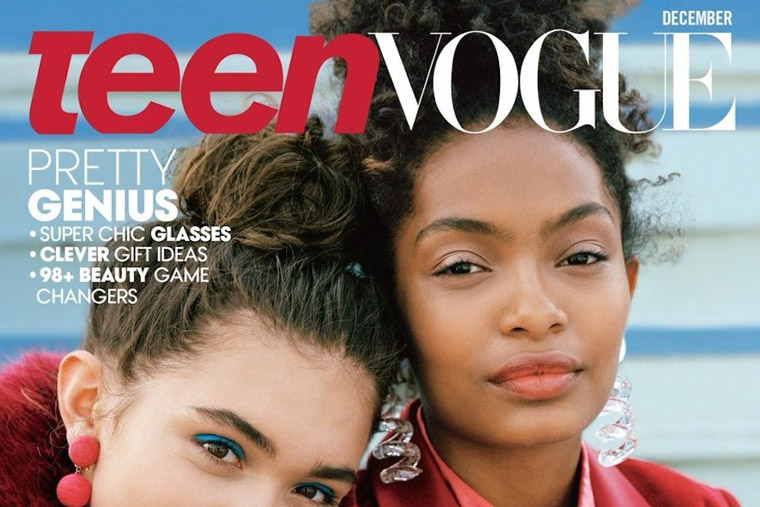One of this season’s biggest trends? Political awareness and active citizenship.
Over the last few months, fashion magazines have been making headlines instead of just writing them, thanks to critical and in-depth coverage of politics, most notably from Teen Vogue. Apparently, it’s still shocking that women and teen girls could be interested in a publication that includes both fashion/beauty must-haves and thoughtful pieces about politics.
The article garnering much recent attention is a piece by Lauren Duca, published on Teen Vogue in December. Her op-ed, “Donald Trump is Gaslighting America,” is a no-holds-barred critique of Donald Trump and how he is destabilizing truth and civil rights. It’s scathing. It’s thoughtful. And it appears along with articles like “15 Times Simone Biles’ Beauty Game Was Worth All the Gold Medals” and “This Is What Your Favourite Celebs Wear on Snow Days.”
The prominence of news and politics articles on Teen Vogue proves how eager young women are for thoughtful coverage of current events. Mark Joseph Stern wrote a piece for Slate celebrating Teen Vogue’s success at political coverage and posited two main reasons why the magazine has been able to produce consistently high-quality and progressive coverage: “First, the magazine clearly goes out of its way to hire women, writers of colour and sexual minorities – groups that, sadly, remain underrepresented at most outlets. This inclusion of diverse voices pushes the magazine in bold editorial directions. Writers are clearly encouraged to pursue their passions, which include pressing, topical issues …
“Second … [under] Welteroth and Picardi’s direction, Teen Vogue has become a clearinghouse for liberal news and ideas with a proud activist streak. The magazine does not feign objectivity, soft-pedal politicians’ bigotry or attempt to present “both sides” of an issue in which there is no legitimate debate.”
Rather than pursue the development of straightforward and balanced reporting, Stern says, Teen Vogue has built a reputation for taking a fierce editorial stance. While they do produce softer content typically associated with teen mags, “the magazine also treats teenagers like rounded human beings with agency and intellects. The result is a teen glossy with seriously good political coverage and legal analysis, an outlet for teenagers who – shockingly! – are able to think about fashion and current events simultaneously.”
However, the coverage in these traditional glossies – and its positive response – isn’t unprecedented. Women’s magazines have regularly dished up political and social discourse alongside fabulous frocks and lipstick recommendations.
Women’s news has often taken a backseat and lacked the appreciation they often deserve; magazines catering to men – such as Esquire, GQ and even the notorious Playboy – have always included a roster of serious topics but women’s glossies were expected to gloss over important subjects. Sady Doyle, in an article for Quartz, quips that “just as it has long been widely understood that Playboy readers could be interested in both modern short fiction and looking at women’s breasts, in the 2010s, only the most dour or dismissive of bros could conclude that serious political engagement is incompatible with an interest in rainbow highlighters. Everyone loves rainbow highlighters. They make you look like a beautiful pixie who fronts a glamrock band. Also, white nationalism is a cancer on our democracy. Women are capable of holding both of these truths in their minds and prioritizing them accordingly.”
Teen Vogue isn’t the only fashion publication offering thoughtful political coverage. Fashion and lifestyle magazines including Glamour, Cosmopolitan, Vogue, Vanity Fair, Marie Claire and many others have a legacy of including political reporting and governmental affairs.
Sure, it may seem like a frivolous place to get your news but one of the things fashion reporting arguably does best is disseminate and interpret information about trends, which applies perfectly to this kind of coverage. With too few outlets covering issues like women’s health and social issues, these stories are essential and in demand.
An added benefit is it also offers a gateway to readers who might not be gathering this information from other sources. In the case of magazines like Teen Vogue, which target a teen/youth readership, this coverage might spur on an increased interest in these topics and encourage young women to seek out additional sources.
Marcie Bianco, the managing editor at Stanford University’s Clayman Institute for Gender Research, told Mercury News that “feminist activists have always turned to media – first print and, now, digital – to cultivate their voices, share their opinions and foster feminist dialogue and community.”
Rather than inventing a new approach, fashion and lifestyle magazines are returning to their roots; from articles encouraging women to take more independent roles in suffragette publications in the 1860s to Helen Gurley Brown encouraging Cosmopolitan’s single, career-focused readers to own their sexuality a hundred years later, women’s magazines have always had periods of thoughtful political commentary.
– Danielle S. Fuechtmann, Editor-in-Chief
image via The Atlantic





